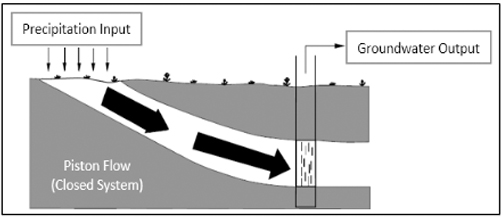Estimating Mean Residence Time of Groundwater in Central Basin/Erbil using Environmental Isotopes
DOI:
https://doi.org/10.21271/ZJPAS.35.3.4Keywords:
Isotopes in Erbil, Oxygen-18, Groundwater, Residence TimeAbstract
The average time of input water needs to recharge the groundwater basin and reach a catchment outlet, whether it follows a vertical or horizontal flow direction, is known as the mean residence time (MRT). This study aims to identify the theory concepts of estimation MRT of groundwater in a well using environmental isotope technique. For this purpose, the spatiotemporal data of oxygen-18 of precipitation in Erbil city were taken from Global Network of Isotopes in Precipitation (GNIP). Furthermore, a well named (HWL) in Erbil city that located at central basin of groundwater were selected. Because of δ18O measured as a natural tracer for estimation MRT in groundwater, the sample analyzed for isotope by using the cavity ring down spectrometer. The derivation of sine wave regression was used to measure δ 18O variations in both precipitation and groundwater.
Decreasing isotopic amplitude of δ18O due to the phase shift from input (precipitation) which is 5.74 ‰ to output (groundwater) to 0.277 ‰ can solve by sine wave equation to estimate MRT of groundwater in aquifer. Results showed that, by temporal response of groundwater to precipitation inputs, MRT from HWL well in Erbil city estimated was 1202 days. This concluded that groundwater spent about 1202 days for recharging HWL well.
2The comparison of δ18O in precipitation and groundwater in Erbil city range from -10.1 to -2.4 per mill for rainfall. These values varied from -7.05 to -6.86 when inters groundwater from HWL well which are typically affected by a reflection of the current state climates.
References
Clark, Ian D., and Peter Fritz. 2013. Environmental Isotopes in Hydrogeology Environmental Isotopes in Hydrogeology.
Hssaisoune, Mohammed et al. 2022. “Isotopic and Chemical Tracing for Residence Time and Recharge Mechanisms of Groundwater under Semi-Arid Climate: Case from Rif Mountains (Northern Morocco).” Geosciences (Switzerland) 12(2).
Jeelani, Ghulam, Rouf A. Shah, and Rajendrakumar D. Deshpande. 2018. “Application of Water Isotopes to Identify the Sources of Groundwater Recharge in a Karstified Landscape of Western Himalaya.” Journal of Climate Change 4(1): 37–47.
Kavousi, Alireza, and Ezzat Raeisi. 2015. “Estimation of Groundwater Mean Residence Time in Unconfined Karst ESTIMATION OF GROUNDWATER MEAN RESIDENCE TIME IN UNCONFINED KARST AQUIFERS USING RECESSION CURVES.” (August).
Kralik, Martin. 2015. “How to Estimate Mean Residence Times of Groundwater.” Procedia Earth and Planetary Science 13(January): 301–6. http://dx.doi.org/10.1016/j.proeps.2015.07.070.
Kuo, Ching Huei, Pi Yi Li, Jun Yi Lin, and Yi Lin Chen. 2022. “Integrating Stable Isotopes with Mean Residence Time Estimation to Characterize Groundwater Circulation in a Metamorphic Geothermal Field in Yilan, Taiwan.” Water (Switzerland) 14(1).
Schmidt, Axel, Michael Engel, Simon Mischel, and Dirk Radny. 2022. “Estimation of Groundwater Mean Residence Times in a Near-Surface Aquifer Using Different Natural Tracers ( Radon-222 , Sulfur-35 , Tritium , and δ 18 O ).” (ii).
Seeyan S, Merkel B. 2014. “Determination of Recharge by Means of Isotopes and Water Chemistry in Shaqlawa-Harrir Basin, Kurdistan Region, Iraq.” Journal of Waste Water Treatment & Analysis 05(03).
Shah, Rouf A, Ghulam Jeelani, and Noble Jacob. 2017. “Estimating Mean Residence Time of Karst Groundwater in Mountainous Catchments of Western Himalaya , India.” Hydrological Sciences Journal 0(0). http://dx.doi.org/10.1080/02626667.2017.1313420.
Tekleab, S., J. Wenninger, and S. Uhlenbrook. 2014. “Characterisation of Stable Isotopes to Identify Residence Times and Runoff Components in Two Meso-Scale Catchments in the Abay/Upper Blue Nile Basin, Ethiopia.” Hydrology and Earth System Sciences 18(6): 2415–31.
Texas Department of Transportation. 2016. “Geohydraulic Aspects.” Hydraulics designs manual: 25–40.
Wang, Shaoyong et al. 2022. “Estimation of Water Residence Time in a Permafrost Catchment in the Central Tibetan Plateau Using Long-Term Water Stable Isotopic Data.” The Cryosphere (June): 1–25.
Zhou, Jing et al. 2021. “Using Stable Isotopes as Tracer to Investigate Hydrological Condition and Estimate Water Residence Time in a Plain Region, Chengdu, China.” Scientific Reports 11(1): 1–12. https://doi.org/10.1038/s41598-021-82349-3.
Waterisotope website for data available at: https://wateriso.utah.edu/waterisotopes/pages/data_access/data_tables.html

Downloads
Published
How to Cite
Issue
Section
License
Copyright (c) 2023 Bruska S. Mamand, Dana K. Mawlood

This work is licensed under a Creative Commons Attribution 4.0 International License.













